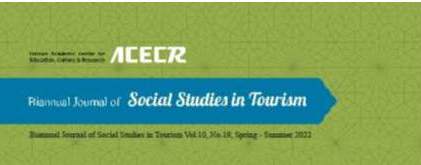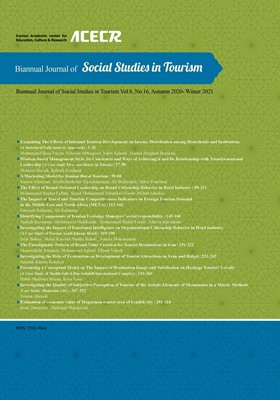-
-
List of Articles
-
Open Access Article
1 - The Impact of Inbound Tourism Development on the Income Distribution among Households and Institutions (A Structural Path Analysis Approach)
Mohammadreza Farzin Niloofar Abbaspoor Yekta Ashrafi Hamid Zargham Boroojeni -
Open Access Article
2 - Wisdom-based management style and the structures and paths to achieve it and its relationship with transformational leadership (Case study: five star hotels in Tehran)
Rabeah Zandipak* -
Open Access Article
3 - A marketing model for Iranian rural tourism
سمیرا الهیاری Abolfazl Tajzadehnamin Ali Badizadeh akbar pourfaraj -
Open Access Article
4 - The effect of brand-oriented leadership on brand citizenship behavior in Hotel Industry
Mohammad Bagher Fallahi Seyed Mohammad Tabataba'i-Nasab Mehdi Sabokro -
Open Access Article
5 - The Impact of Travel and Tourism Competitiveness Indicators on Foreign Tourism Demand in the Middle East and North Africa (MENA)
Fatemeh Rahmani Ali Rahnama -
Open Access Article
6 - Discovering the components of social responsibility for ecolodge managers in Iran
Sadegh Kazemian Gholamreza Malekzadeh Mahdi Farahi Alireza Khorakian -
Open Access Article
7 - Impact of Emotional Intelligence on Organizational Citizenship Behavior in the Hotel Industry (Case Study: Parsian Azadi Khazar Hotel)
jafar bahari mehdi karoubi Shahla Bahari Samira Mohammadi -
Open Access Article
8 - The paradigmatic pattern of brand value creation for tourism destinations in Iran
manouchehr jahanian Mohammad aghaei elham vahedi -
Open Access Article
9 - Development of ecotourism, and its role in the development of ecotourism attractions in Aran and Bidgol
sajedeh karimi -
Open Access Article
10 - The Impact of Destination Image and Satisfaction on Heritage Tourists’ Loyalty: resenting a Conceptual Model (Case Study: World Collection of Sheikh Safi al-Din Ardabili)
Habib Shahbazi Shiran Roya Esmi -
Open Access Article
11 - Investigating the Quality of Subjective Perception of Tourists of the Artistic lements of Monuments in a Mixed- Methods Case Study: Hamedan City
Tooran Ahmadi -
Open Access Article
12 - Estimation of the Economic Value of Mogarmon Tourist Area Using the Contingent aluation and Individual Travel Costs Approaches
iman danaeifar mehrdad mehdizadeh
-
The rights to this website are owned by the Raimag Press Management System.
Copyright © 2017-2025







